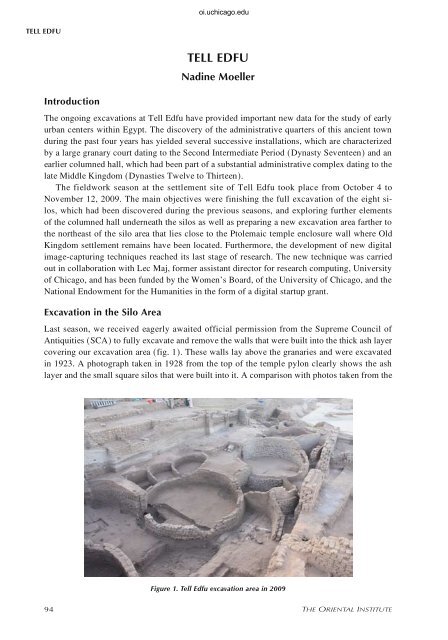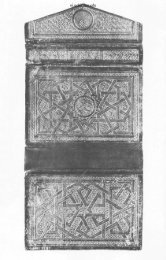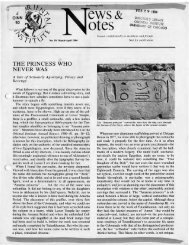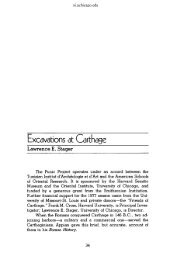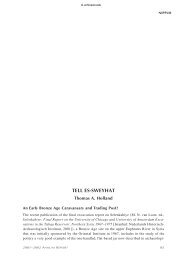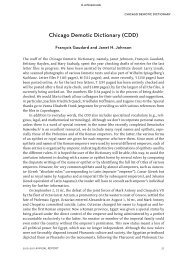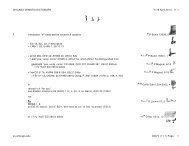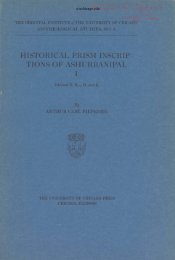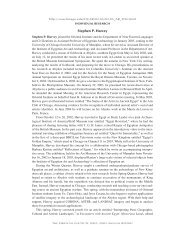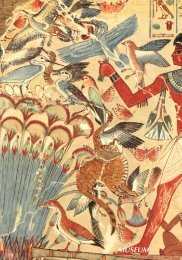TELL EDFU. Nadine Moeller - Oriental Institute - University of Chicago
TELL EDFU. Nadine Moeller - Oriental Institute - University of Chicago
TELL EDFU. Nadine Moeller - Oriental Institute - University of Chicago
Create successful ePaper yourself
Turn your PDF publications into a flip-book with our unique Google optimized e-Paper software.
Tell edfu<br />
Introduction<br />
Tell edfu<br />
<strong>Nadine</strong> <strong>Moeller</strong><br />
The ongoing excavations at Tell Edfu have provided important new data for the study <strong>of</strong> early<br />
urban centers within Egypt. The discovery <strong>of</strong> the administrative quarters <strong>of</strong> this ancient town<br />
during the past four years has yielded several successive installations, which are characterized<br />
by a large granary court dating to the Second Intermediate Period (Dynasty Seventeen) and an<br />
earlier columned hall, which had been part <strong>of</strong> a substantial administrative complex dating to the<br />
late Middle Kingdom (Dynasties Twelve to Thirteen).<br />
The fieldwork season at the settlement site <strong>of</strong> Tell Edfu took place from October 4 to<br />
November 12, 2009. The main objectives were finishing the full excavation <strong>of</strong> the eight silos,<br />
which had been discovered during the previous seasons, � and exploring further elements<br />
<strong>of</strong> the columned hall underneath the silos as well as preparing a new excavation area farther to<br />
the northeast <strong>of</strong> the silo area that lies close to the Ptolemaic temple enclosure wall where Old<br />
Kingdom settlement remains have been located. Furthermore, the development <strong>of</strong> new digital<br />
image-capturing techniques reached its last stage <strong>of</strong> research. The new technique was carried<br />
out in collaboration with Lec Maj, former assistant director for research computing, <strong>University</strong><br />
<strong>of</strong> <strong>Chicago</strong>, and has been funded by the Women’s Board, <strong>of</strong> the <strong>University</strong> <strong>of</strong> <strong>Chicago</strong>, and the<br />
National Endowment for the Humanities in the form <strong>of</strong> a digital startup grant.<br />
excavation in the Silo Area<br />
oi.uchicago.edu<br />
Last season, we received eagerly awaited <strong>of</strong>ficial permission from the Supreme Council <strong>of</strong><br />
Antiquities (SCA) to fully excavate and remove the walls that were built into the thick ash layer<br />
covering our excavation area (fig. 1). These walls lay above the granaries and were excavated<br />
in 1923. A photograph taken in 1928 from the top <strong>of</strong> the temple pylon clearly shows the ash<br />
layer and the small square silos that were built into it. A comparison with photos taken from the<br />
Figure 1. Tell Edfu excavation area in 2009<br />
94 The OrienTal insTiTuTe
Tell edfu<br />
pylon in 2008 shows that most <strong>of</strong> the walls that are lying above our excavation area were already<br />
excavated more than eighty years ago. Over the past three seasons at Tell Edfu, we recorded<br />
these walls in all their detail with drawings, descriptions, and photographs as well as an analysis<br />
<strong>of</strong> the few stratigraphic connections still preserved. Thus, we have now obtained the necessary<br />
information for the forthcoming publication in the first volume <strong>of</strong> the Edfu Reports series.<br />
During the excavation <strong>of</strong> these wall remains, we have been able for the first time to provide<br />
a precise date for them. The few remains <strong>of</strong> in situ layers connected to these walls (since most<br />
<strong>of</strong> them were removed during the previous excavations) contained pottery that dates to the Late<br />
Period (Dynasties Twenty-five to Twenty-six). The walls belonged to larger domestic buildings,<br />
which seem to have been characterized by relatively thin walls <strong>of</strong> about 58 to 60 cm in width.<br />
They could have only been used for single-story houses since these walls are not strong enough<br />
to support additional floors above. Further elements <strong>of</strong> these houses were large open courtyards<br />
and numerous square magazines or cellars that had been built deeply into the ground and were<br />
used as storage space. These square magazines were about 1.2 m long and wide and about 2.5 m<br />
deep. Their walls were only one brick thick, about 14 cm, and bricks lined the pits that had been<br />
dug directly into the ground. Their floors were also paved with mudbricks. We have not been<br />
able to discover any original fill inside these magazines, which might have provided evidence<br />
for what exactly had been stored in them. The previous French excavations had already emptied<br />
them in the 1920s and refilled them with their own excavation rubbish, which contained modern<br />
straw and pieces <strong>of</strong> newspapers. In the western part <strong>of</strong> our excavation area, we excavated one<br />
<strong>of</strong> those square magazines, which had the western wall still preserved to its original height at<br />
2.5 m above the floor level. Three small pieces <strong>of</strong> wooden beam fragments found on top <strong>of</strong> the<br />
wall indicated that these magazines were covered with mudbricks and wood. There must have<br />
been a trap door from above to access them, but no traces <strong>of</strong> the latter have been preserved. The<br />
general character <strong>of</strong> these Late Period houses seems to have been private, and no find has led<br />
us to believe otherwise.<br />
New Kingdom Refuse layers<br />
oi.uchicago.edu<br />
The Late Period walls were built over very thick refuse layers, which have been dated to the<br />
first half <strong>of</strong> the New Kingdom. A clear hiatus in occupation can be seen between the abandonment<br />
<strong>of</strong> the Second Intermediate Period silos and the Late Period occupation. So far we have not<br />
discovered any evidence for Ramesside or Third Intermediate Period activities in this zone. A<br />
major change in the function <strong>of</strong> this town quarter from being an administrative, <strong>of</strong>ficial area to<br />
being used as a refuse dump during the Eighteenth Dynasty until the installation <strong>of</strong> Late Period<br />
domestic buildings seems to have occurred. Apart from dumping large amounts <strong>of</strong> white ash (US<br />
2013 in fig. 2) and discarded pottery mixed with occupation debris (US 2458 in fig. 2), there are<br />
few activities that can be observed here that date to the New Kingdom. The white ash might have<br />
been deposited from a nearby bakery since we did not find any traces <strong>of</strong> industrial activity such<br />
as unfired/vitrified pieces <strong>of</strong> pottery that would indicate pottery production or any metal slag that<br />
would be a sign for metal working. A large-scale baking facility somewhere nearby seems to be<br />
the most plausible explanation for the origins <strong>of</strong> the ash. The underlying sequence <strong>of</strong> a multitude<br />
<strong>of</strong> refuse layers (US 2458) containing a lot <strong>of</strong> pottery seems also to stem from some large-scale<br />
production activity nearby. Curious fragments <strong>of</strong> dried mud were found in large quantities in<br />
these layers; their function and origin are so far unknown. Among them were a large number <strong>of</strong><br />
hieratic ostraca, which contain administrative lists. According to the context and paleography,<br />
they date from the late Second Intermediate Period to the early New Kingdom. Ostraca from<br />
2009–2010 annual repOrT 95
Tell edfu<br />
oi.uchicago.edu<br />
Figure 2. Refuse layers <strong>of</strong> the New Kingdom<br />
reliable archaeological contexts are extremely<br />
rare, especially for the period in question.<br />
A large quantity <strong>of</strong> animal bones was also<br />
excavated this year. Of particular note are the<br />
bones <strong>of</strong> several hippopotami. An entire upper<br />
skull (fig. 3) has been discovered in the<br />
area immediately east <strong>of</strong> Silos 405 and 303.<br />
Additionally, multiple pieces <strong>of</strong> jawbones,<br />
tusks, vertebrae, and leg bones have been found<br />
in different contexts in the silo area, some in<br />
the debris layers <strong>of</strong> the New Kingdom, others<br />
in earlier fill layers near the silos. The exact<br />
Figure 3. Hippopotamus upper skull<br />
reason for them being deposited here and the<br />
and vertebra discovered near the silos<br />
puzzling fact that there is more than one occasion<br />
<strong>of</strong> dumping hippo bones are questions that we need to answer in the future.<br />
The Silos <strong>of</strong> the Second Intermediate Period<br />
The excavation <strong>of</strong> the Late Period walls and the refuse/ash layers underneath them allowed us<br />
for the first time to excavate the complete silos <strong>of</strong> which we had dug small parts in previous<br />
seasons (fig. 4). In the southern part, we completed the excavation <strong>of</strong> Silos 393 and 405 down<br />
to their original floor level. In the interior <strong>of</strong> Silo 393, we dug various fill layers and walking<br />
levels, which had accumulated above its original floor. Several small fireplaces visible on the<br />
surface <strong>of</strong> these walking levels indicate some sort <strong>of</strong> use after the actual function <strong>of</strong> the silo as<br />
granary had ceased. Two <strong>of</strong> those fill layers lying above the silo floor contained further hieratic<br />
ostraca that also date from the end <strong>of</strong> the Second Intermediate Period to the early New Kingdom<br />
(fig. 5). They must have been discarded after the silo had fallen out <strong>of</strong> use. They are very similar<br />
96 The OrienTal insTiTuTe
oi.uchicago.edu<br />
Figure 4. Plan <strong>of</strong> the silo area (2009)<br />
Tell edfu<br />
2009–2010 annual repOrT 97
Tell edfu<br />
oi.uchicago.edu<br />
Figure 5. Layer with hieratic ostraca inside silo Si 393<br />
to those found in the northern part <strong>of</strong> the site (layer US 2458) according to their paleography,<br />
suggesting that these pieces come from the same source and period, probably belonging to an<br />
archive that was discarded when the administrative buildings in this area were abandoned. Among<br />
the ostraca three shallow red bowls were found, broken into multiple pieces, which have been<br />
inscribed on the inside and outside in hieratic. These texts will be part <strong>of</strong> a detailed study by<br />
Kathryn Bandy (graduate student in the Department <strong>of</strong> Near Eastern Languages and Civilizations<br />
at the <strong>University</strong> <strong>of</strong> <strong>Chicago</strong>).<br />
The large Silo 303 was also fully excavated (fig. 6). It has a diameter <strong>of</strong> 6 m, and its walls<br />
are preserved up to a height <strong>of</strong> 1.5 m. According to the stratigraphic evidence, this silo belongs<br />
to the first phase <strong>of</strong> silos built in the area and functioned at the same time as Silo 316. Inside<br />
Silo 303 we excavated all the layers down to the floor level <strong>of</strong> the older columned hall <strong>of</strong> the late<br />
Middle Kingdom, which lies underneath the silos. Against its eastern side we discovered three<br />
new silos (Silos 655, 654, and 653), which are abutting Silo 303 (fig. 7). They are much smaller<br />
in size and seem to have functioned as additional storage space. In the central one <strong>of</strong> the three,<br />
Silo 654, an intact female clay figurine was found (fig. 8). It was lying in the demolition layer <strong>of</strong><br />
the silo, which also contained many mudbrick fragments. The figurine shows a woman carrying<br />
a baby on her back. A very similar figure has been discovered at Gebel Zeit in the sanctuary for<br />
Hathor. These figurines are typical for the Second Intermediate Period and have been interpreted<br />
as fertility figurines. In 2006 we found several such figurines in the demolition fill <strong>of</strong> Silo 316,<br />
though none <strong>of</strong> them with a baby.<br />
It is now clear that Silo 316, together with Silo 303, form the first phase <strong>of</strong> grain silos in this<br />
area. They are characterized by large diameters (6.0–6.5 m), and their walls have a width <strong>of</strong> two<br />
bricks (30.6 cm). Other silos have been built against and around them. This year we uncovered<br />
Silo 388, which leans against Silo 316 on its northern side (fig. 9). The northwestern side <strong>of</strong> Silo<br />
98 The OrienTal insTiTuTe
oi.uchicago.edu<br />
Figure 6. Excavation in progress inside Silo 303<br />
Figure 7. Silos 653, 654, and 655 built against the exterior <strong>of</strong> Silo 303<br />
Tell edfu<br />
2009–2010 annual repOrT 99
Tell edfu<br />
Figure 8. Clay fertility figurine found<br />
inside the silo demolition layer<br />
oi.uchicago.edu<br />
388 is still preserved to a height <strong>of</strong> more than 3 m above<br />
floor level, and the curvature <strong>of</strong> the dome is easily visible,<br />
yet very fragile. This silo seems to have also been previously<br />
excavated, probably by the French in the 1920s or<br />
1930s because it was filled with excavation debris.<br />
Silo 388 could well be contemporary with the construction<br />
<strong>of</strong> the eastern Silo 323 and/or Silo 313. We cannot<br />
establish a precise relative chronology just yet since we<br />
are still missing some stratigraphic links in this area, which<br />
will be brought to light in excavation next season. Thus<br />
the floor <strong>of</strong> Silo 388 had not been reached by the end <strong>of</strong><br />
this season, and it is one <strong>of</strong> the aims for 2010. This silo<br />
had been built at a time when the grain storage area was<br />
restructured. The main visible transformation was a considerable<br />
reduction <strong>of</strong> the size <strong>of</strong> the grain silos. In fact,<br />
in the north a 2.2 m high wall running east–west was constructed,<br />
reducing the extension <strong>of</strong> the silo court toward<br />
the north. A part <strong>of</strong> another silo wall can be seen that was<br />
integrated into this wall. This shows us not only that in its<br />
original layout the granary courtyard stretched farther in<br />
that direction but also that the latter silo could well have<br />
been contemporary to Silo 316 and Silo 303 since it shares<br />
identical architectural features.<br />
Figure 9. Silos in the northern part <strong>of</strong> the excavation area<br />
100 The OrienTal insTiTuTe
oi.uchicago.edu<br />
Columned Hall <strong>of</strong> the Middle Kingdom<br />
Tell edfu<br />
Remains <strong>of</strong> a large columned hall were discovered underneath the silos, and this hall has been<br />
another focus <strong>of</strong> our excavations since its first discovery in 2005. We can reconstruct sixteen<br />
columns in total so far, but the eastern part <strong>of</strong> the building is still covered by later settlement<br />
layers, and thus the exact limits to the east are unknown. Last season we found new data in connection<br />
with the use <strong>of</strong> this late Middle Kingdom administrative building. Inside Silo 303 we<br />
excavated below the silo floors down to the thick mud floor <strong>of</strong> the columned hall. We found one<br />
more sandstone column base, which makes a total <strong>of</strong> six column bases in situ, while two other<br />
column bases were ripped out shortly after the building had fallen out <strong>of</strong> use and before the silos<br />
were built, leaving two large holes in the ground. The holes are clearly visible (fig. 10). On the<br />
mud floor we discovered a layer <strong>of</strong> abandonment, which corresponds to the exact moment when<br />
the columned hall was no longer used; only discarded pottery and various objects mixed with<br />
animal bones were left lying on the floor. Apart from many pieces <strong>of</strong> pottery, there were two<br />
interesting discoveries that merit mention here. We found numerous fired pottery weights, each <strong>of</strong><br />
which has two holes and a deep groove running along the upper part that would have held a rope.<br />
Maybe they were used as net sinkers for weighing down fishing nets. Further analysis is planned<br />
in order to determine their precise function. Among the abundant pottery, a small group <strong>of</strong> sherds<br />
can be identified as Levantine Painted Ware. The sherds belong to at least one bichrome longnecked<br />
jug, the decoration <strong>of</strong> which includes a black crisscross zone with a red band above and<br />
below as well as an additional black band below (fig. 11). Fragments <strong>of</strong> the body are preserved,<br />
but the shoulder, neck, and handle are missing. Close parallels to these imports have also been<br />
found at Tell el-Dab’a during the late Middle Kingdom. This type <strong>of</strong> pottery has been found in<br />
the Levant and in Egypt and can be dated to the beginning <strong>of</strong> the Middle Bronze Age.<br />
On and above the floor <strong>of</strong> the columned hall we also found numerous seal impressions indicating<br />
the opening and sealing <strong>of</strong> various commodities (boxes, baskets, letters) in this area.<br />
Figure 10. Abandonment layer <strong>of</strong> the columned hall<br />
2009–2010 annual repOrT 101
Tell edfu<br />
Figure 11. Pieces <strong>of</strong> Levantine Painted Ware jug found<br />
in the columned hall abandonment layer<br />
oi.uchicago.edu<br />
The majority are scarab seals showing the typical decorative spiral motifs <strong>of</strong> the late Middle<br />
Kingdom; however, a few have personal names and titles. In 2007 we discovered several seal<br />
impressions showing the figure <strong>of</strong> a king wearing the crown <strong>of</strong> Upper and Lower Egypt with a<br />
tiny cartouche in front <strong>of</strong> his face that can be read as “Nimaatre,” which is the throne name <strong>of</strong><br />
Amenemhat III (see News & Notes 198).<br />
Another new discovery in relation to the columned hall was made this season. On the surface<br />
<strong>of</strong> the newly excavated column base we were able for the first time to clearly see the negative<br />
imprint left by the removal <strong>of</strong> the actual column that had originally stood there. When removed,<br />
its negative imprint remained visible (fig. 12). We now have clear evidence that the columns<br />
were octagonal and most likely made <strong>of</strong> wood.<br />
Preparation <strong>of</strong> New excavation layer with Old Kingdom Remains<br />
In the north <strong>of</strong> the silo area, just behind the new mudbrick wall that was built by the SCA in 2002,<br />
we cleared several meters <strong>of</strong> sebbakh debris in order to access the underlying Old Kingdom layers<br />
(fig. 13). The cuts along the sides contained pottery dating to the Fourth and Sixth Dynasties,<br />
which would provide for the first time new information about the origins <strong>of</strong> the ancient town at<br />
Edfu. So far we know almost nothing about the provinces during the Fourth Dynasty since all<br />
the activity seems to have been concentrated in the Memphite region, Giza-Saqqara. We stopped<br />
the excavation here as soon as we reached in situ layers, which we will start to carefully excavate<br />
next season. This season’s work was aimed at preparing the ground for the 2010 season. It seems<br />
that the sebbakhin had cut several large holes into the ground here, but there is enough material<br />
still in its original place that is worth excavating and studying. This would also be an ideal area<br />
to present our finished work to the tourists and visitors, since it can be seen from current ground<br />
level, and no access or climbing on the tell is required.<br />
digital documentation <strong>of</strong> Archaeological Remains<br />
Figure 12. Negative imprint <strong>of</strong> an octagonal<br />
column visible on a column base<br />
A side project <strong>of</strong> the Tell Edfu Project focuses on the development <strong>of</strong> new digital image-capturing<br />
techniques for which research has been carried out in collaboration with Lec Maj. Work on site<br />
concentrated this year on the 3-D modeling aspect <strong>of</strong> this project using PhotoModeler Scanner<br />
s<strong>of</strong>tware. As a study sample, we chose the digital recording <strong>of</strong> the lower part <strong>of</strong> a Ptolemaic house<br />
102 The OrienTal insTiTuTe
Figure 13. Work in progress during preparation <strong>of</strong> new excavation area<br />
Tell edfu<br />
that was excavated by the Franco-Polish mission in the 1930s and is still preserved in excellent<br />
condition (fig. 14). One <strong>of</strong> the challenges was to find the best possible reference markers, which<br />
are used for the automatic alignment <strong>of</strong> photographs to create a 3-D photo skeleton for extracting<br />
point-cloud data. In the field the local conditions such as strong sunlight created inevitable<br />
shadows, and the winds and the occasional roaming <strong>of</strong> wild dogs provided quite a few challenges.<br />
Another study sample was the female fertility figurine with the baby on her back. The processing<br />
<strong>of</strong> this data and the final generation <strong>of</strong> the 3-D models are currently in progress. Two other<br />
aspects <strong>of</strong> the project have been<br />
successfully completed. One<br />
is an adaptation <strong>of</strong> panoramic<br />
photography using a stationary<br />
tripod with a panoramic tripod<br />
head in order to capture general<br />
views <strong>of</strong> the excavations area.<br />
The other makes use <strong>of</strong> a photographic<br />
stitching program called<br />
Micros<strong>of</strong>t Photosynth, which is<br />
available online. The latter permits<br />
very detailed views <strong>of</strong> the<br />
archaeological remains that can<br />
be zoomed into, which are generated<br />
by numerous photos taken<br />
Figure 14. Lower part <strong>of</strong> a Ptolemaic house showing<br />
reference markers used for 3-D modeling<br />
oi.uchicago.edu<br />
from many different angles with<br />
2009–2010 annual repOrT 103
Tell edfu<br />
different, overlapping reference points. First results can be seen on the Tell Edfu Project Web<br />
site at www.telledfu.org.<br />
**********<br />
I would like to thank Dr. Mohamed al-Bialy from the Aswan Inspectorate, and Mr. Mohamed<br />
Zenan Nubi as well as his colleagues from the inspectorate at Edfu for their ongoing support and<br />
help. A special thank you also goes to our inspector Dr. Sami es- Zeidan Osman for his collaboration<br />
and Ms. Faten Abd el-Halim Saleh for her help with the paperwork and its Arabic translation.<br />
The members <strong>of</strong> the Tell Edfu team were (in alphabetical order) Natasha Ayers (ceramics),<br />
Kathryn Bandy (ostraca and small finds), Georges Demid<strong>of</strong>f (Egyptology), Elise MacArthur<br />
(archaeology and photography), Lec Maj (computing and 3-D modelling), Gregory Marouard<br />
(archaeology), Virpi Perunka (ceramics), Foy Scalf (Demotic ostraca), Aurelie Schenk (archaeology),<br />
and Julia Schmied (photography).<br />
Credit<br />
All photos and drawings by the Tell Edfu Project 2009.<br />
Web site: www.telledfu.org<br />
oi.uchicago.edu<br />
——————————<br />
104 The OrienTal insTiTuTe


